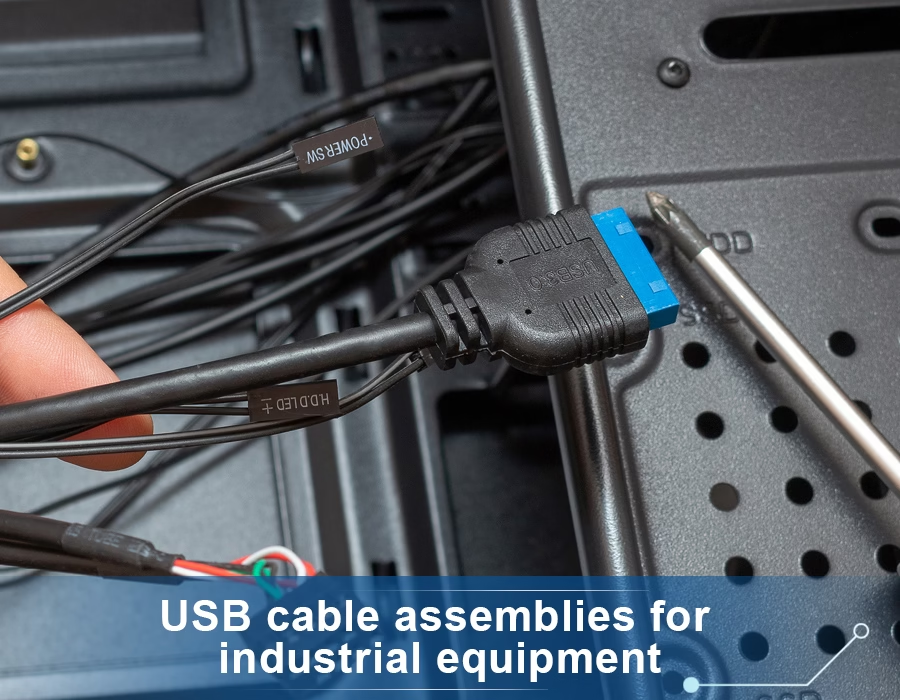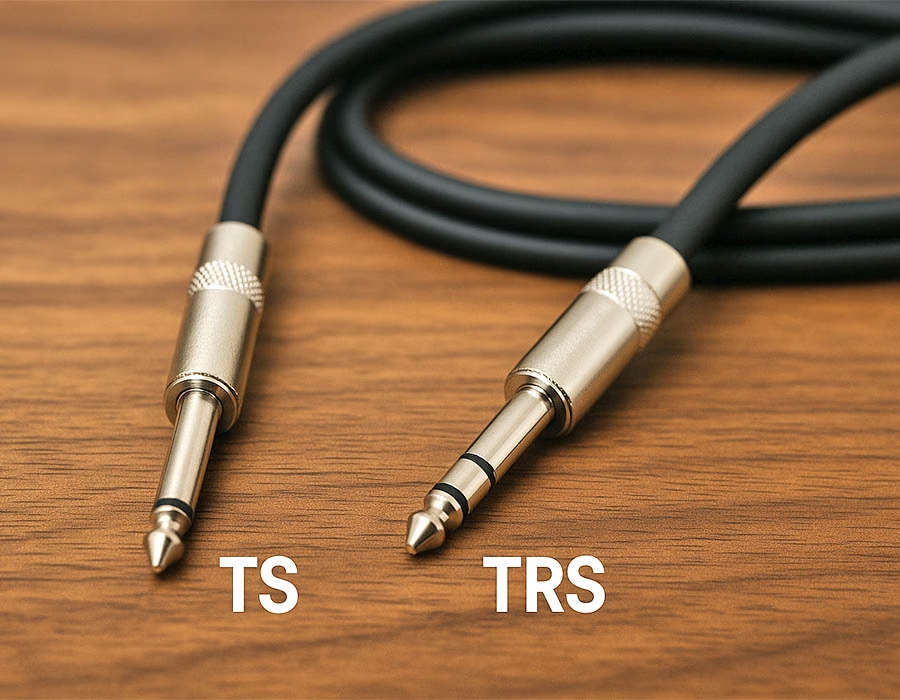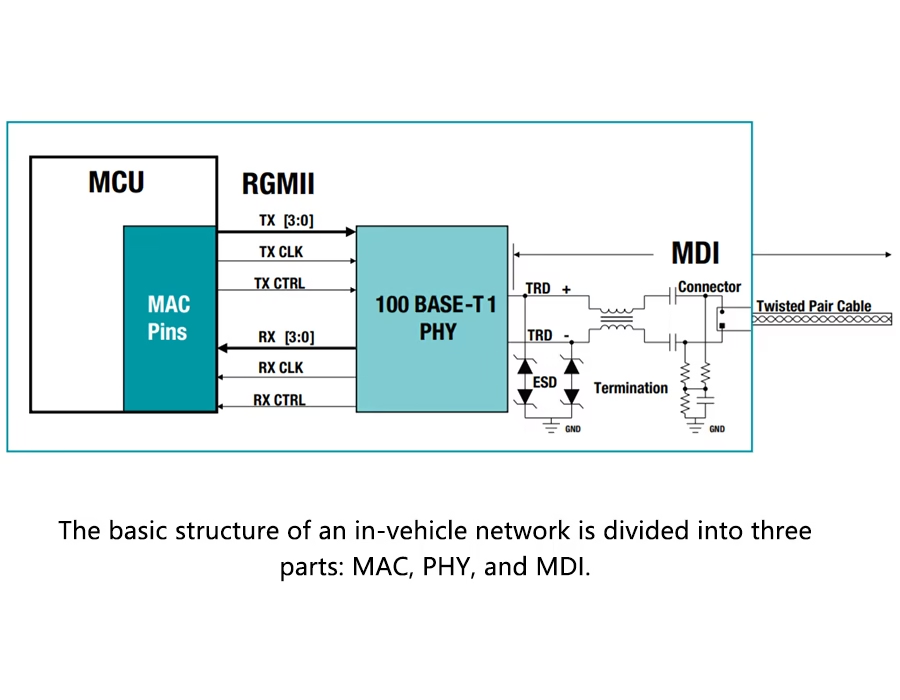
USB cable assemblies are pre-made cables featuring USB plugs on both ends, designed to transfer data and power between devices. They combine multiple copper wires (for data and +5 V power) inside a single jacket, often with shielding and strain relief molded onto the ends. In practice, you connect one end to a host (such as a PC or industrial controller) and the other to a peripheral device (such as a sensor, camera, or printer).
USB is widely used—from desktop PCs to industrial PLCs—because it provides power and data over a single cable, simplifying system design. A USB cable assembly is essentially the finished product that engineers use; it is certified to USB standards and comes with connectors already attached.
Key Components of USB Cable Assemblies
USB cable assemblies typically consist of several parts, each serving a clear purpose:
- USB Connectors: Plugs at each end (Type-A, Type-B, Type-C, Micro, Mini, etc.) connect to host and device sockets. Modern assemblies often utilize USB-C due to its reversible design and enhanced power/data capabilities.
- Copper Conductors: The cable contains several conductors (wires). A USB 2.0 cable typically has four wires: two red/black for +5V power and ground, and two green/white twisted for differential data (D+ and D-). USB 3.x assemblies include additional twisted pairs for SuperSpeed data.
- Shielding: To prevent electromagnetic interference (EMI), foil and braided metal shields are wrapped around the wires to protect against interference. High-speed data (USB 3.0 and beyond) requires shielding to guarantee signal integrity in noisy situations.
- Outer Jacket & Overmolding: The bundle is completely wrapped in an insulating jacket (e.g., PVC, LSZH) and overmolded at the ends. This molded plastic provides strain relief, preventing cable bends from straining the solder joints. Metal or plastic armor can be added under the jacket in tough assemblies to improve crush resistance.
- Ferrite Cores (Optional): Some assemblies use ferrite beads or cores near the ends to help reduce high-frequency noise on the lines. These are commonly used in medical or broadcast equipment cables to reduce interference.
System designers may request specialized assemblies (with specific lengths, color-coded jackets, and connectors). Every component—connector type, wire gauge, shielding quality—is chosen to meet data-rate, power, and environmental standards.
🔧 Looking to ensure your USB cable assemblies meet industrial-grade reliability?
Romtronic crafts fully compliant USB cable assemblies with durable jackets, rigorous shielding, and strain relief to withstand harsh environments.
👉 Contact our engineering team for a custom solution →
How USB Cable Assemblies Work
USB cable assemblies are passive carriers that adhere to USB requirements for power and data transfer. When hooked in, the host device (such as a computer or PLC) provides +5V on the VBUS line and communicates with the peripheral via data lines. The twisted pair of wires (D+ and D-) transmit a serial bitstream at speeds ranging from 1.5 Mbps (USB 1.x) to 480 Mbps (USB 2.0) and 5 Gbps (USB 3.0). Using a differential pair and strong shielding reduces crosstalk, ensuring consistent high-speed signaling even in electrically noisy environments.
A USB cable assembly functions in conjunction with the USB protocol. When you attach the cable, the host detects the device’s presence via the ID pin or data line pull-ups, powers it (5V), and starts enumeration. The assembly does not actively manipulate the data; it just transmits signals and power. In industrial designs, engineers often prefer USB cables that meet or exceed the USB-IF’s specifications for impedance, signal loss, and durability. A USB 3.0 cable assembly requires precise twisting and shielding to provide full-duplex transfers (with four additional SuperSpeed wires) without signal loss.
Some USB assemblies incorporate connectors or functionality to meet system requirements. Panel-mount USB 3.0 cables may include locking connections or thumbscrew flanges to keep them in place. Others could be waterproof (IP67) USB assemblies with threaded couplings and O-rings for outdoor or wash-down applications. In all circumstances, the essential objective is the same: to provide power and digital signals neatly and reliably in a single cable unit.
Applications in Industrial and Electronic Systems
USB cable assemblies are used to interface USB-compatible devices. USB ports are commonly found on factory floors in industrial automation equipment, including PLCs, HMIs, barcode scanners, sensors, and actuators. These locations require ruggedness: assemblies with insulated, armored cables and secure connectors ensure uptime. Machine vision cameras often use shielded USB 3.0 cables with locking thumbscrews to prevent disconnection.
In electronics and instrumentation, USB assemblies connect PCs and laptops to lab instruments, data recorders, and test equipment. Engineers place a premium on data integrity and compliance: cables are often compliant with USB-IF, UL, and EMI/EMC standards, ensuring that measurements remain accurate. USB is also used by medical devices (monitors, scanners); low-smoke, zero-halogen (LSZH) jackets may be used in clinics for further safety.
USB is also widely used in consumer electronics, with cameras, cellphones, and peripherals all including USB cables (typically USB-C) for charging and data sync. USB-C assemblies are widely used in modern laptops and mobile devices for quick charging and high-speed video/data transfer.
Certain trends stand out across various applications. The latest component designs support higher power (USB Power Delivery) and faster data transfer (USB 3.1/3.2/4). They offer adaptable solutions for confined spaces (right-angle plugs) and harsh environments (IP ratings, braided shielding). Industrial-grade USB components integrate multiple features, including armored shielding, low-smoke, zero-halogen jackets, panel-mount flanges, 90° or 45° angled connectors, and locking mechanisms. The resulting USB cable assemblies are engineered for demanding system environments.
⚡ Need a USB cable assembly that works under extreme conditions—vibration, moisture, or tight spaces?
Romtronic provides rugged IP-rated, overmolded USB assemblies with options for right-angle connectors, armored shielding, and compliance with USB-IF and UL standards.
👉 Discuss your custom requirements with our specialists →
USB Cable Assembly Components (Summary Table)
| Component | Description |
|---|---|
| USB Connectors | Plug connectors (Type A/B/C, Micro, Mini) – the ends that mate with devices. |
| Conductors (Wires) | Copper wires: a differential data pair (D+/D–) plus power (+5 V) and ground. USB 3.x adds extra data pairs. |
| Shielding | Foil and braided metal shield wrapped around wires to block EMI/RFI. |
| Jacket & Overmold | Outer insulating jacket and molded plug boot that protect wires and provide strain relief. |
| Ferrite Beads | Optional noise filters (magnetic cores) on ends to suppress high-frequency interference. |
FAQs
A: A USB cable assembly is an entirely constructed and tested cable with connectors on both ends, ready for plug-and-play operation. In other words, it’s the finished product that you install on your machine. A bare USB cable (or a cable harness) would need you to install connectors or terminate lines yourself. Assemblies are built to strict USB specifications and often include certifications (such as USB-IF and UL) to ensure proper functioning.
A: Standard USB 2.0 cables include four wires: one pair for +5V power and ground, and one twisted pair for differential data (D+ and D-). USB 3.x cables include eight wires: the original four plus two more twisted pairs for SuperSpeed transmit/receive, and some have extra ground lines. Micro and USB-C cables include an additional ID or sideband pin. All of these wires are packed into the assembly’s jacket.
A: Shielding is critical in noisy or industrial settings. The metal foil/braid reduces external EMI/RFI, which can degrade high-speed transmissions. USB 3.0 (5 Gbps) requires proper shielding to ensure signal quality. Armored jackets (with metal or plastic layers) protect the cable from crushing or abrasion on the factory floor. To remain reliable in areas with vibration or snagging risk, cables frequently include robust jackets, locking connectors, and built-in strain reliefs.
A: The most popular USB connectors are Type-A (flat rectangular, generally host side) and Type-B (square-ish, usually peripheral side) for old USB, as well as the new Type-C (compact, reversible plug used on newer gadgets). Micro-B and Mini-B connectors are smaller versions commonly found on cameras and older mobile devices. Many assemblies allow you to combine connections (for example, Type-A to Type-C). Industrial kits also include panel-mount variants and connectors with thumbscrews or latches for secure installation.
A: Look for assemblies that are rated for their environmental and data requirements. To transmit high-speed data, ensure that the assembly is USB-IF compliant. For harsh environments, consider features such as LSZH or heavy-duty jackets, IP-rated connectors, or locking ends. Check that it meets safety criteria (such as UL listing). Consider cable length (longer runs may require active repeater cables). In brief, match the assembly’s specifications (speed, power, and durability) to your application needs.
.avif)
Sam Wu is the Marketing Manager at Romtronic, holding a degree in Mechatronics. With 12 years of experience in sales within the electronic wiring harness industry, he manages marketing efforts across Europe. An expert in cable assembly, wiring harnesses, and advanced connectivity solutions, Sam simplifies complex technologies, offering clear, actionable advice to help you confidently navigate your electrical projects.


